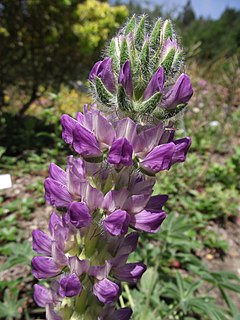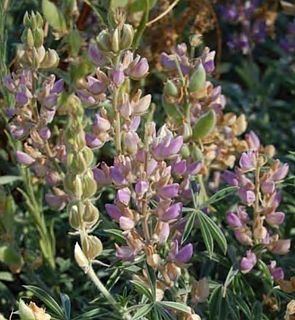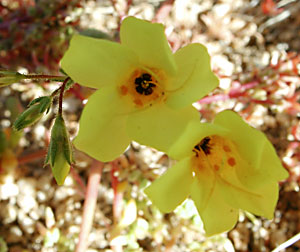
Lupinus polyphyllus, the large-leaved lupine, big-leaved lupine, many-leaved lupine, blue-pod lupine, or, primarily in cultivation, garden lupin, is a species of lupine (lupin) native to western North America from southern Alaska and British Columbia east to Quebec, and western Wyoming, and south to Utah and California. It commonly grows along streams and creeks, preferring moist habitats.

Lupinus, commonly known as lupin, lupine, or regionally bluebonnet etc., is a genus of flowering plants in the legume family Fabaceae. The genus includes over 199 species, with centers of diversity in North and South America. Smaller centers occur in North Africa and the Mediterranean. They are widely cultivated, both as a food source and as ornamental plants, although in the Nordic countries and New Zealand's South Island, introduced lupins are viewed as a severe environmental threat.

Lupinus arboreus, the yellow bush lupine (US) or tree lupin (UK), is a species of flowering plant in the legume family Fabaceae.

Pinus contorta, with the common names lodgepole pine and shore pine, and also known as twisted pine, and contorta pine, is a common tree in western North America. It is common near the ocean shore and in dry montane forests to the subalpine, but is rare in lowland rain forests. Like all pines, it is an evergreen conifer.

Pinus ponderosa, commonly known as the ponderosa pine, bull pine, blackjack pine, western yellow-pine, or filipinus pine is a very large pine tree species of variable habitat native to mountainous regions of western North America. It is the most widely distributed pine species in North America.

Armeria maritima, the thrift, sea thrift or sea pink, is a species of flowering plant in the family Plumbaginaceae. It is a compact evergreen perennial which grows in low clumps and sends up long stems that support globes of bright pink flowers. In some cases purple, white or red flowers also occur. It is a popular garden flower and has been distributed worldwide as a garden and cut flower. It does well in gardens designed as xeriscapes or rock gardens.

Lupinus microcarpus, the wide-bannered lupine or chick lupine, is a species of lupine native to western North America from southwestern British Columbia south through Oregon and California, including the Mojave Desert, and into Baja California. There is also a disjunct population in South America, with locations in central Chile and western Argentina.

Eriogonum fasciculatum is a species of wild buckwheat known by the common names California buckwheat and eastern Mojave buckwheat.

Dudleya abramsiisubsp. setchellii, known by the common name Dudleya setchellii, the Santa Clara Valley dudleya, or Santa Clara Valley liveforever, is a member of the Dudleya genus of succulent perennials, members of the family Crassulaceae. The Santa Clara Valley dudleya, endemic to the Santa Clara Valley region in the southern San Francisco Bay Area, was listed on February 3, 1995, as an endangered species. It is considered to be a subspecies of Dudleya abramsii, but its taxonomic status is still unclear. Its closest relative is Dudleya cymosa subsp. paniculata, which is a morphologically similar sister taxon.

Ericameria nauseosa, commonly known as Chamisa, rubber rabbitbrush, and gray rabbitbrush, is a North American shrub in the sunflower family (Aster). It grows in the arid regions of western Canada, western United States and northern Mexico.

Lupinus bicolor is a species of lupine known as the miniature lupine, Lindley's annual lupine, pigmy-leaved lupine, or bicolor lupine.

Lupinus excubitus is a species of lupine known as the grape soda lupine. Its common name refers to its sweet scent, which is said to be very reminiscent of grape soda. This species and its variants are found in Southwestern United States, especially in California and Nevada, e.g., Death Valley and Joshua Tree National Parks, and northwestern Mexico.

Heterotheca sessiliflora is a species of flowering plant in the daisy family known by the common name sessileflower false goldenaster. It is native to California, Sonora, and Baja California.

Sambucus racemosa is a species of elderberry known by the common names red elderberry and red-berried elder.

Lupinus albifrons, silver lupine, white-leaf bush lupine, or evergreen lupine, is a species of lupine (lupin). It is native to California and Oregon, where it grows along the coast and in dry and open meadows, prairies and forest clearings. It is a member of several plant communities, including coastal sage scrub, chaparral, northern coastal scrub, foothill woodland, and yellow pine forest.

Chrysothamnus viscidiflorus is a species of shrub in the daisy family of the Americas known by the common names yellow rabbitbrush and green rabbitbrush.

Mentzelia multiflora, commonly known as Adonis blazingstar, Adonis stickleaf, desert blazingstar, prairie stickleaf and manyflowered mentzelia is a herbaceous perennial wildflower of the family Loasaceae.

Lupinus formosus, the summer lupine or western lupine, is a species of flowering plant in the legume family, Fabaceae. It is native to California and Oregon in the United States.

Leptosiphon aureus is a species of flowering plant in the phlox family known by the common name golden linanthus.

Icaricia icarioides blackmorei, the Puget blue, is a butterfly native to the Puget Sound area in the northwestern U.S. state of Washington. It is a subspecies of Boisduval's blue.




















